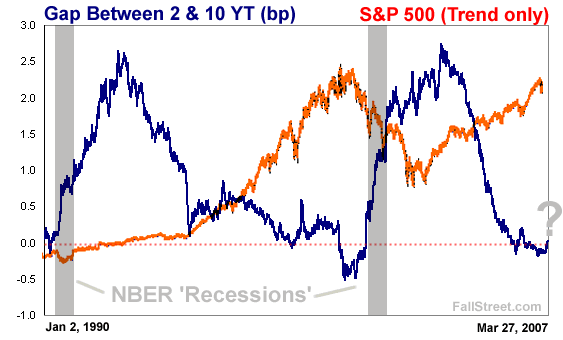Learning Curves - Yield Curve turns Positive, Recession ?
Economics / US Economy Mar 28, 2007 - 10:30 AM GMTBy: Brady_Willett
Yesterday CBS's Mark Hulbert attacked bearish 'advisors' that neglected to announce that the U.S. yield curve was no longer inverted. Apparently Mr. Hulbert believes that those who pointed out that recession usually follows a curve inversion should have immediately ratcheted down their recession odds because the curve told them to do so.
"I'd be a very poor man if my wealth were dependent on getting a dollar for every one of those advisers who, since late last week, has even acknowledged that the yield curve has become positive again - much less conceded that, by the logic of their previous argument, a recession has become less likely.
It just goes to show how difficult it is to be truly objective in this business."
To back up his highly speculative claims Hulbert noted (without actually citing) a Fed model:
"According to one widely-cited econometric model that two Federal Reserve economists created a decade ago, in fact, this shift [in the curve] reduces the probability of a recession by no more than between 5 and 10%."
Isn't ironic that while attacking nameless 'advisors' for ignoring the curve today Mr. Hulbert neglects to mention that nearly every Fed member was singing 'this time things will be different' when the curve inverted in late 2005? Are we to assume from what Hulbert says that the 'advisors' are not to be trusted but Federal Reserve employees with a computer in front of them are completely objective?
Ominous Curve Patterns Live!
Yes, the majority of advisors are biased: they tend to focus on statistics and events to support their conclusions and/or investment position. However, Hulbert's premise that the yield curve is being ignored by bears because it no longer helps their doomsday scenarios is backed by little more than attitude. In fact, a good case can be made that the yield curve turning positive is a signal that either bond investors or the Fed* have concluded that the U.S. economy is weakening so rapidly that it is in desperate need of stimulus.
Am I being objective? I think so. After all, when the curve finally turned 'not-inverted' on December 29, 2000 the recession did not arrive until 2001, and when the curve turned positive in March 1990 the recession did not arrive until July 1990. In other words, the inverted yield curve - which presaged each of the last two recessions - was actually turning sharply positive by the time recession arrived.

* As for the Fed possibly influencing recent interest rate gyrations, at threat of being labeled a crackpot I will allow Mr. Bernanke's own words describe what may be going on in the bond market. Mr. Bernanke released these comments earlier this week, and, for the record, they went completely unmentioned by Hulbert and others.
"...the Federal Reserve has the capacity to operate in domestic money markets to maintain interest rates at a level consistent with our economic goals" China's build-up of U.S. debt okay - Fed chief
Could it be the case that the markets have already gotten their first unofficial rate cut from the always easy U.S. Fed? If so, isn't the 'not-inverted' curve a 'real-time' indicator of a deepening economic slump? I am sure Mr. Hulbert can find some model to help us bears better understand why rate cuts take 6-12 months to work their magic...why not lend a hand Mark?
Conclusions and Biased Speculations
The carnage in subprime is at threat of spreading, lending standards are tightening, the U.S. consumer is up to their eyeballs in debt, the Fed is praying that inflationary forces remain in check, and the yield curve has turned positive. At risk of being labeled myopic, I tend to think the curve is the last of these worth mentioning.
But if forced to, I would remind everyone that the curve turned negative on December 27, 2005, in 2006 the curve spent 81-trading sessions in the positive, and today's positive spin is all of 5-sessions old. In an economic system supported by asset bubbles, leverage, and/or reckless lending/borrowing, I tend to believe these curve trends have lost much of their importance. After all, the basic premise that when lenders step up to bat they must see an attractive short/long pitch to take a swing has been blown-up by the incredible growth in credit since 2005. But, if forced to, I would add that a continued rise in the curve may be an indicator of recession rather than recovery.
http://www.treas.gov/offices/domestic-finance/debt-management/interest-rate/yield.shtml
By Brady Willett
FallStreet.com
Copyright © 2007 FallStreet.com
FallStreet.com was launched in January of 2000 with the mandate of providing an alternative opinion on the U.S. equity markets. In the context of an uncritical herd euphoria that characterizes the mainstream media, Fallstreet strives to provide investors with the information they need to make informed investment decisions. To that end, we provide a clearinghouse for bearish and value-oriented investment information, independent research, and an investment newsletter containing specific company selections.
© 2005-2022 http://www.MarketOracle.co.uk - The Market Oracle is a FREE Daily Financial Markets Analysis & Forecasting online publication.



